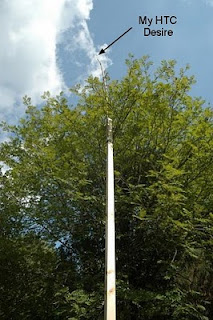I found two apps in the Android Market which report and log cell data: "Antennas" and "RF Signal Tracker". I enabled the logging on both apps and cycled around the area. In the immediate vicinity of where I was staying the signal was almost non-existent. But not far away there was acceptable signal levels.
It turns out these apps not only record cell ID, and signal strength, but also (from somewhere?!) downloads the location of the cell towers.
Plotting this data on Google Maps yielded some answers. It turns out the tower was to the north and not the east as I had originally thought. The signal into the valley was being attenuated by a ridge of the Caha Pass a little higher than the tower (despite no line-of-sight, diffraction of radio waves allows some signal through). On either side of the ridge were peaks exceeding 400m elevation: so it would appear this constrained reception to a beam within the valley.
My data would appear to confirm this. Within the yellow wedge it seemed possible to get a signal (red dots indicate points where I could connect). In the grey wedge a signal was mostly not obtainable.
Data acquisition and visualization
I ran both "Antennas" and "RF Signal Strength" together. The UI in the latter app wasn't very good... it was slow to respond and would frequently hang. Fortunately the logging function worked. The "Antennas" UI on the other hand appeared to work better, but failed to log much data.
The data from "RF Signal Strength" looks like this:
_id,latitude,longitude,rssi,logdate,mcc,mnc,lac,cellid,site_lat,site_lng,tech,ber,callstate,roaming 1,51766086,-9613348,-99,14 Aug 2010 13:56:03,272,1,47,11011,52181474,-1357067,GPRS,-1,IDLE,NO 2,51766086,-9613348,-99,14 Aug 2010 13:56:26,272,1,47,11011,52181474,-1357067,GPRS,-1,IDLE,NO 3,51766086,-9613348,-99,14 Aug 2010 13:56:27,272,1,47,11011,52181474,-1357067,GPRS,-1,IDLE,NO
I wrote a script (Java + Javascript) to plot this on Google Maps Terrain layer. Then copied a screen grab into Google Draw Tool to annotate.

